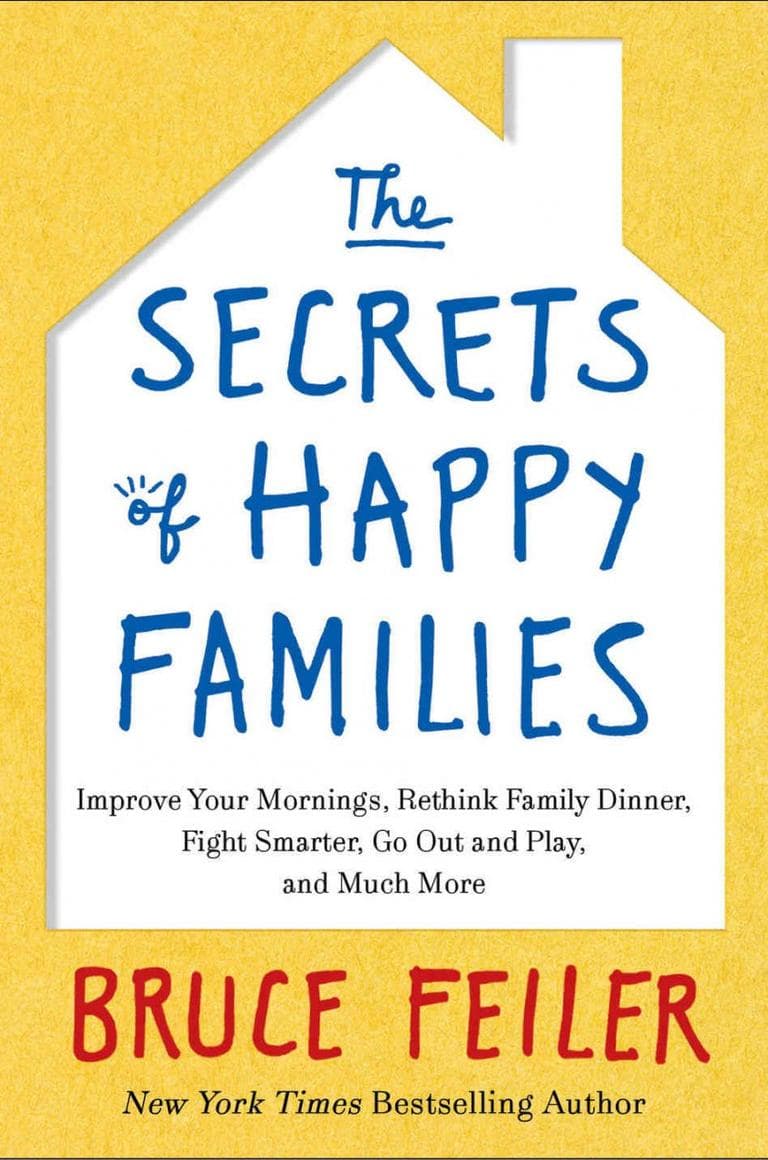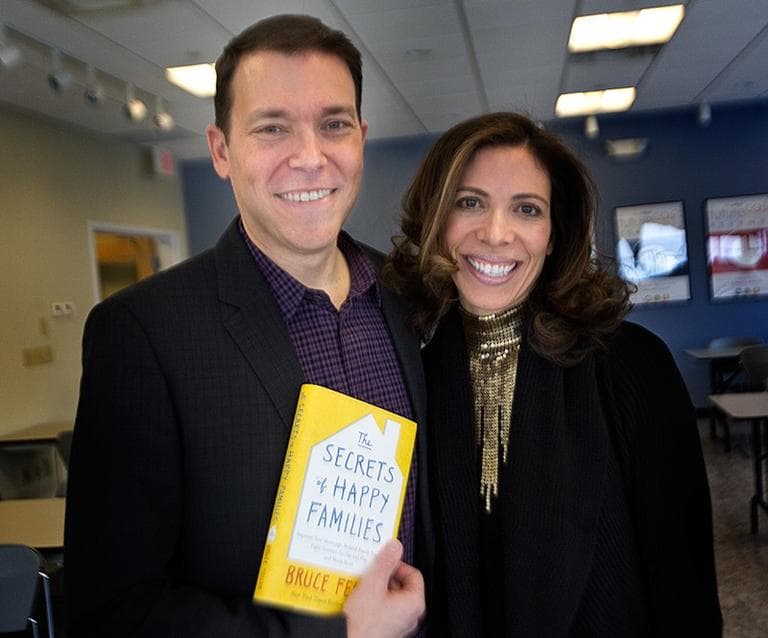Advertisement
Author Shares 'The Secrets Of Happy Families'

New York Times columnist and author Bruce Feiler is always searching for answers. He's the guy who walked the Bible and explored why the story of Moses is so enduring.
His latest project hits closer to home.
Feiler and his wife Linda Rottenberg are the parents of twin girls and when they found their daily life growing more chaotic and hectic, Bruce decided to look for help.
He wanted to know what makes a happy family. So he consulted a wide ranging group of people, green berets, coaches, software engineers and branding experts.
The result was his new book, "The Secrets Of Happy Families: Improve Your Mornings, Rethink Family Dinner, Fight Smarter, Go Out and Play, and Much More."
Some suggestions include:
- Don’t worry about family dinner.
- Let your kids pick their punishments.
- Ditch the sex talk.
- Cancel date night.
Feiler hopes "if you take just one idea from each chapter in this book your family will be transformed in less than a week."
Intrigued? Read an excerpt below to see if he's onto something, and tell us what you think of his idea on Facebook or in the comments. You can also share your secrets to a happy family here.
____ Book Excerpt: 'The Secrets of Happy Families'
by Bruce Feiler

The last fifty years have seen a wholesale revolution in what it means to be a family. We have blended families, patchwork families, adoptive families. We have nuclear families that live in separate houses as well as divorced families that nest in the same house. We have families with one parent, two parents, three parents, or more, and families with one, two, or three faiths, and some with none.
No matter what kind of family you are part of, an enormous new body of research shows that your family is central to your overall happiness and well-being. Study after study confirms that the number one predictor of life satisfaction comes from spending time with people you care about and who also care about you. Simply put, happiness is other people, and the other people we hang around with most are our family.
Advertisement
So how do we make sure we’re doing that effectively? The last decade has seen a stunning breakthrough in knowledge about how to make families, along with other small groups, run more smoothly. Myth-shattering research from neuroscience to genetics has completely reshaped our understanding of how parents should discipline their children, what to talk about at family dinner, and how adult siblings can have difficult conversations. Cutting-edge innovation in social networking and business has transformed how people work in groups. Trend-setting programs from the U.S. military to professional sports have introduced remarkable techniques for making teams function more efficiently and bounce back from setbacks more quickly.
But most of these revolutionary ideas remain ghettoized in their subcultures, where they are hidden from the people—the families—who need them most.
This book is designed to make a dent in that problem.

I have tried to write the book I have most wanted to read as a spouse, parent, uncle, sibling, and adult child. I’ve broken down families into the things we all do—love, fight, eat, play; fool around, spend money, make pivotal life decisions—and tried to discover ways to do them better. I have sought out the most illuminating experiences, the smartest people, and the most effective families I could find as a way to assemble best practices of families today. My goal was to put together a playbook for happy families.
Most of these ideas have been hiding in plain sight. I took a course from the founder of the Harvard Negotiation Project on how to fight smart. I visited ESPN to find out what the best coaches know about building successful teams. I worked with Green Berets to design a perfect family reunion. I got some advice from Warren Buffett’s banker about how to set up an allowance. I sat down with top game designers in Silicon Valley to see how we can make family vacations more fun.
And on one of my favorite days, I visited the set of Modern Family. The most popular show on American television captures many of the crosscurrents in families today. There’s a suburban family battling everything from technology to dating. There’s a gay couple with an adopted Vietnamese daughter. There’s a grumpy grandfather with a Colombian trophy wife and a day-trading, lovelorn son.
A key part of Modern Family’s success is that no matter how outrageous the characters act or how loony a story is, the writers pull a string just before the final commercial and the family comes together in a reassuring hug. I’d sure like one of those strings! I talked to the cast and creators about what the success of Modern Family says about modern families and whether we should all live our lives more like a sitcom.
In the course of this research, I also encountered a shocking array of outdated advice and ill-informed recommendations, and this book became something of a crusade against a few fashionable trends.
The first is the family improvement industry. Of the nearly two hundred books I read, the ones by therapists, counselors, child-rearing experts, or other traditional “authorities” on family life were by far the least helpful. It’s not that they were ill-informed or poorly written. It’s that they seemed tired and out of date. The questions seemed retread from thirty or even forty years ago; the answers seemed stale. A century after Freud, this once-innovative field seems to offer few original ideas.
At the same time, nearly everything else about contemporary life is being remade and re-imagined. Where are the fresh ideas for families? Early on, I set the goal of speaking with the leading lights of technology, business, sports, and the military about the innovative ideas they bring home to their families. I made a parallel goal of not speaking with any therapist. (For the record, I violated that goal only once, when I met with a Belgian sex therapist, and boy was I glad I did!)
The second trend is the happiness movement. Anyone who’s stepped into a bookstore or scanned the Internet in recent years knows a new field emerged in the early twenty-first century called positive psychology. Pioneered by a group of visionary scholars, the movement shifted attention away from the longstanding focus on individuals with mental illness or other pathologies and concentrated on high-functioning individuals and what the rest of us could learn from them. The field exploded, and I, like many, have learned a tremendous amount from this exciting literature.
But as even the leading practitioners of positive psychology have complained, all the attention on individual happiness has also made our culture more shallow and self-centered. A primary tenet of most happiness books, for example, is to figure out what makes us happy. Yet among the things proven to make us the least happy are raising children, tending aging parents, and doing household chores. That’s 80 percent of my waking hours!
We need to take the central premise of the happiness movement—its focus on those who do it right—and apply it to the area of our lives that’s been scandalously overlooked: our families.
Finally, the parenting wars. The last few years have seen an outpouring of books, articles, and magazine covers wrangling over the issue of what’s the proper way to raise children. Be strict like the Chinese; no, be lax like the French; spank ‘em like they did in the good ‘ol days of the good ‘ol U.S. of A. These debates are fiery, passionate, and oddly familiar. Isn’t the tough-minded Tiger Mom just the inverse of the permissive Dr. Spock?
The authors of those books have an ideology they want to promote. I don’t. I don’t have a country I’m trying to emulate. I don’t have a mascot. I have a question: What do happy families do right and how can the rest of us learn to make our families happier?
And I have a conviction: No matter what I find, I’m not going to reduce it to a list of five, six, or seven things you absolutely must do create the perfect family. In 1989, Stephen Covey published The 7 Habits of Highly Effective People, one of the most successful self-help books ever written. It has sold more than twenty-five million copies. The book spawned countless imitators seeking to identify “5 Easy Steps” or “Six Simple Truths.” The Internet, with its emphasis on bite-sized wisdom, has only accelerated this trend. As every blogger, Tweeter, and Pinterest poster knows, readers love lists. I’ve certainly digested my share of such lists (and generated more than a few myself), but secretly I hate them. They stress me out because I’m always worried I’m going to forget number 4 or disagree with number 2.
So in this book I’ve tried to go to the opposite extreme. I’ve strived to generate a fresh gathering of best practices for each of the subjects I tackled. Not just parenting, but also marriage, sex, money, sports, and grandparenting. My goal was to create The List to End All Lists, more than 200 bold new for improving your family. While that might seem overwhelming, please hear me out.
A collection like this is liberating, I believe, because it’s obvious no one can attend to them all. If you’re like Linda and me, a few will make you uncomfortable. Do I have to use the word vagina when giving my daughters a bath instead of the more demure “privates”? A few you might not agree with at first. What do you mean I should cancel date night? And a few you might simply reject. Let your kids decide their own punishments?
But if you’re also like us, you’ll be shocked by how much you didn’t know and jazzed to get started trying out some new techniques. I’m almost prepared to guarantee that you’ve never encountered at least three-quarters of the ideas in this book. (With us, I’d put the figure at 90 percent.) And I’m betting at least a few of them will be useful. My hope is that if you take just one idea from each chapter in this book your family will be transformed in less than a week.
And who among us doesn’t want that? For all the lip service we pay to families in our culture, most of us have a nagging fear we’re not doing it as well as we might. We know our families are the single biggest influence on our well-being, yet we spend surprisingly little time trying to improve them. Just listen to the conversations we have all the time: We’re busy; we’re harried; we’re overwhelmed. We feel time slipping away. Having beaten the biological clock to have our kids; now we race a different ticking clock to help convert those kids into a family.
And we can. Everything I’ve learned persuades me it’s possible to give our children a secure, loving family culture they can carry with them throughout their lives. It’s possible to include grandparents, siblings, even bumbling Cousin Joe in an extended community of nurturing and support. It’s possible to have a happy family.
Nearly a century and a half ago, the great Russian novelist Leo Tolstoy began Anna Karenina with one of the most famous lines in all of world literature. “All happy families are alike; each unhappy family is unhappy in its own way.” When I first encountered this line, I thought the first half, in particular, was inane. Of course all happy families are not alike: Some are large, some are small; some are boisterous, some are quiet; some are traditional, some are non-traditional.
Writing this book has changed my mind. Recent scholarship has allowed us, for the first time in history, to identify some building blocks that high-functioning families share; to understand the techniques effective families use to overcome challenges; to pinpoint the skills each of us needs to conduct ourselves more successfully in this most maddening of human institutions. Is it possible, all these years later, to say Tolstoy was right: All happy families do have certain things in common?
That answer, I believe, is yes. Come, let me show you why.
Excerpted from "The Secrets of Happy Families: Improve Your Mornings, Rethink Family Dinner, Fight Smarter, Go Out and Play, and Much More" by Bruce Feiler. Copyright (c) 2013 Bruce Feiler. To be published on February 19, 2013. Reprinted by permission of William Morrow, an imprint of HarperCollinsPublishers.
Guests:
- Bruce Feiler, author of "The Secrets of Happy Families."
- Linda Rottenberg, CEO and co-founder of the nonprofit Endeavor.
This segment aired on February 25, 2013.